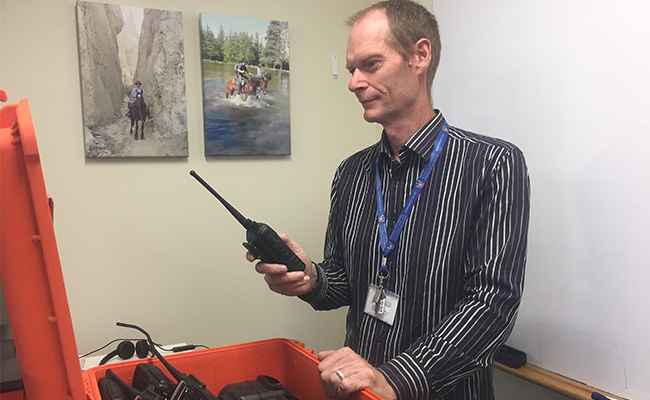 Paul McNamara with portable radio handsets the University has as an alternative means of communications in an event.
Paul McNamara with portable radio handsets the University has as an alternative means of communications in an event.
University Emergency Management and Business Continuity Co-ordinator Paul McNamara can remember the exact date COVID-19 reared its head again.
It was August 17 last year, his second day in the job. Talk about hit the ground running.
“My first day, I was sitting down working out a plan to present to my manager of what I viewed my priorities were, focussing on business continuity.
“Then suddenly I was working from home in isolation having Zoom calls with all these new faces and trying to ensure that I wasn't upsetting what was already in place because the university has done a fantastic job with COVID
“I had to quickly learn the university's take on the Coordinated Incident Management System, and how all the working parts fit together. And I was really fortunate that I had a very good knowledgeable team of people who aided me with the transition.”
Each day brought fresh challenges as the University responded to an evolving pandemic situation.
“There are some aspects which unique to the university environment, which was quite a steep learning curve for me. For example, last year dealing with students who were in a red zone of Auckland wanting to return and the processes around that.”
Fast-forward to 2022 and the Omicron variant's arrival in Dunedin at the start of the academic year triggered a new emergency response with student and staff welfare at the forefront.
The University reactivated the Incident Management Team and the daily flurry of Zooms calls started again.
A typical day would start with a meeting of the “control function managers” of the Incident Management Team, covering planning and intelligence (Rob Wilks) logistics and operations (Russ Linwood), operations (Martin Jones), welfare (Ray O'Brien) and communications (Christian Macfarlane).
“It gives us the opportunity to raise any issues before they become major or determine if there are any major issues that need to be sorted out straight away.
“You're concentrating on things like what's happening in the colleges? What's happening with staffing and people being fed. Are we missing anyone in the community who is vulnerable? Have we got the right level of oversight of what's going on?
“There's a saying that you should have 80% planned work and 20% unplanned work. But the reality of emergency management is you have 20% planned work and 80% unplanned work, because how you start your day is not how you finish your day.”
A briefing with senior leaders would often follow the morning meeting and then the larger Incident Management Team across all campuses would meet.
“Soon after I started here, I realised that the right people are around the table. You've got the people who are going to be affected by something helping make the decisions. One of the things which has been overarching is the focus on student welfare and staff welfare. This is something you can lose sight of when things are coming thick and fast but it's always been at the forefront and that's really, really great.”
Emergency management has dominated in recent months, but Paul is hoping he can now begin to switch his focus to the other half of his job, business continuity. This is about putting in place plans and process to ensure critical University services have built-in resilient.
“Business continuity looks at the risks and what controls are in place. For example, if your research unit has minus 50degree freezers do you have a generator so you don't lose 25 years' worth of research when the power goes off?
“Also, what are the upstream and downstream dependencies? If this unit stops working, who else is this going to affect? I don't write the business continuity plan as only the people who work in that area understand fully what it is that they do and the priority of their functions. I'm there to give departments the tools, help them with advice and make the process as painless as possible.”
